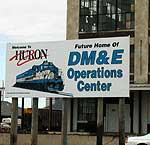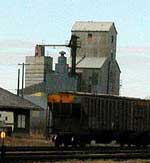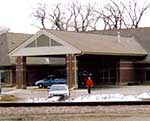By Erin Galbally
Minnesota Public Radio
March 11, 2002
|
|
RealAudio |
In the late 1800s, the railroad brought new residents to young cities and towns. Trains hauled carloads of crops to previously inaccessible markets. Soon industry followed, lining the tracks like magnets. Now an ambitious expansion plan from the Dakota, Minnesota and Eastern Railroad has many communities along the line contemplating their roots.
| |
|
|
|
||
If the Dakota, Minnesota and Eastern Railroad successfully accomplishes its $1.5 billion plan, coal could soon be en route from Wyoming's Powder River Basin to power plants in the east. Along the hundreds of miles of new and rehabilitated track, Huron, S.D., has emerged as an anchor. It is here the DM&E plans to build its center of operations. That distinction is expected to mean 700 new jobs.
Robert Hohm grew up in Huron. His father was a doctor for the Chicago Northwestern rail line. He remembers stories of nasty winter storms that stopped trains on the track. And he wistfully recalls an era of prosperity that went hand-in-hand with the railroad's development.
"This town was founded as the headquarters for the Chicago Northwestern Railroad. There was a reason that Huron, S.D., had the biggest hotel back in the '30s. In 1938, the statistics show that Huron had the most active airport in South Dakota," says Hohm.
More recent history hasn't been quite so kind to Huron. Five years ago a major employer, Dakota Pork, closed its doors, putting 800 people out of work. The city's overall population also took a substantial hit.
| |
|
|
|
||
According to city leaders, the DM&E's expansion holds the power to revive their economy. They believe once a new set of rail spikes hits the soil next spring, businesses will flock to town. Some people predict new jobs will keep young people in Huron, and maybe even bring more students in local schools.
Officials hope the shift in demographics will bring in more tax dollars. Shawn Lyons, the executive director of the Greater Huron Development Corp., says the whole region will suffer without the project. The corporation's Web site shows a DM&E train rolling through South Dakota countryside.
"If the project doesn't move forward, frankly you're looking at no rail line at all," says Lyons. "It would be devastating to a community like Huron, that's invested a lot of emotion and financial support behind this project. But you're going to be looking at many faceless communities - like Midland and other communities - that a lot of people don't know about, but to whom the project is very significant."
Lyons might as well be talking about the small southwestern Minnesota town of Springfield. Springfield was settled by the railroad back in the 1870s. It's a town where agriculture still fuels the local economy, and Main Street is lined with old-fashioned prairie style brick buildings.
But Springfield is blending old with new. Less than 1,000 yards from the town's railroad tracks is a brand new community center. On a marble plaque inside the center's front hall, the DM&E railroad is listed a major donor.
| |
|
|
|
||
Ben Luense serves on the community center's board and heads the local bank. Luense says more trains mean a stronger local economy.
"You ask local people how many trains go through Springfield in a day's time, (they say) 'I don't know, maybe two or three.' In reality, there's anywhere between five and eight trains in a 24-hour period," says Luense. "People just don't think about it. It happens."
Luense, like other Springfield officials, says more DM&E trains mean big benefits for area farmers. The region produces an estimated $45 million worth of corn and soybeans each year. The railroad's expansion could shave 7 cents per bushel off transportation costs for produce shipped down the line.
Springfield City Manager Malcolm Tilberg says those benefits far outweigh any inconveniences brought on by increased train traffic.
"If it means you wake up in the middle of the night when the train whistles go through town, or you have to wait at a crossing for a few minutes more, or you have to be concerned about your community safety - suppose all of these are worthwhile if we can have a strong ag economy, and continue to support the rural farming areas which are the hand the feeds the mouth in rural Minnesota," Tilberg says.
| |
|
|
|
||
Not all towns along the line share Springfield and Huron's enthusiasm for the railroad's expansion. Rochester and the Mayo Clinic have waged a well-funded campaign against the plan for years. As a result, the relationship between the southeastern Minnesota community and the railroad is starkly different.
At a recent public meeting organized against the expansion, Olmsted County Commissioner Mike Podulke questioned the railroad's willingness to work with the city.
"Negotiations with the railroad is having them not come to a meeting - then the newspaper accusing us of abandoning negotiations," says Podulke. "When you shake hands with the railroad, count your fingers. If they say it's Tuesday, get ready for Sunday church!"
The dispute is all about whether or not the trains should go through town. Rochester leaders insist increased train traffic will jeopardize the Mayo Clinic's bottom line. They've lobbied for plan that would send coal trains through countryside on a bypass that would cost an estimated $100 million.
The president of the DM&E has said repeatedly the price of the bypass would derail the entire project. A federal transportation board agreed. Rochester and the Mayo Clinic have filed suit challenging that decision.
Terry Adkins, Rochester city attorney, says the railroad and the federal government have ignored the city's concerns.
| |
|
|
|
||
"It's a project's failure to accommodate the citizens in this city in terms of their health, safety and well being," says Adkins. "It's a project we have no choice over - we have no options, no say on whether it happens to us."
Adkins is skeptical the railroad will give agriculture the boost many communities are banking on. He says unlike smaller cities and towns that need the railroad - Rochester does not.
Ben Pennington's a published railroad historian and a Rochester resident. Pennington strongly disagrees with the city's position. He says Rochester's stance is ironic, since 40 years ago city and Mayo Clinic officials were bemoaning the loss of passenger rail service.
"The fact that Rochester doesn't use the railroad as heavily as it once did does not mitigate the fact that the tracks come through town," says Pennington. "Tracks have for almost 140 years, along the property the tracks are on. They are one of the longest-running landowners in town. It's interesting - you look at history and you actually see the truth."
To date, Rochester has spent more than $600,000 in public money to fight the railroad project. Their lawsuit is expected to be heard in St. Louis, home to the U.S. 8th Circuit Court of Appeals. There it will most likely be combined with two additional cases filed against the DM&E's expansion.
But the DM&E is not standing alone. More than a dozen communities have weighed in on behalf of the railroad project. Once again, small towns are hoping the railroad can give new life to their place on the plains.
More from MPR




